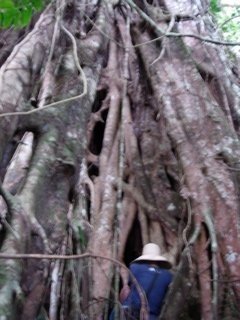In the Visayas region of the Philippines, the tree is also called balite or dalakit. The balete is a relative of the banyan tree. (They are both a type of ficus, or what is also called a strangler fig tree, since the tree grows around a host tree and strangles it.) The balete tree has been mentioned during my interviews with healers and sorcerers, for my film project The Shamans of Siquijor. It has been described as a magical place and as a dwelling for supernatural beings.

Balete tree, San Antonio, Siquijor
It was a rainy day. The kind of day where schoolchildren walk home in their uniforms, using giant leaves of tropical plants (the kind we in the US use as ornamentals in our yards) as umbrellas. Imelda, a native and schoolteacher, showed me the inside of a balete tree in San Antonio, Siquijor. She told me that sorcery rituals are known to take place inside of the tree. The immense tree had a cool, cathedral-like, Lord of the Rings, mysterious feeling. I found remnants of melted candles, small bottles, and other remains from rituals past on the interior floor and sides of the tree.
In the book Cebuano Sorcery (p. 151), anthropologist Richard Lieban describes angyaw, a sorcery method, where the “sorcerer goes to an enchanted place where he communicates with a spirit who assists him in his practice of malign magic.”
Source: Lieban, Richard. Cebuano Sorcery. Berkeley: University of California Press, 1967.
Examples of such methods, mentioned in the study Illness and Healing by Bishop Julito Cortes, and in my field interviews, are angyaw sa: minteryo (cemetery); langub (cave); ong-ong (haunted pit); dalakit (haunted tree)
Definition
The definition of the balite or dalakit is:
“A name given to various species of Ficus which start as epiphytes and strangle their host, assuming tree form. They are much feared as being haunts of various supernatural beings.”
Source: Wolff, John U. A Dictionary of Cebuano Visayan. Ithaca, New York: Cornell University Library, 1972.
During the course of my research, I found that the balete tree has uses in healing and sorcery in the Philippines. Furthermore, the tree has uses and a fascinating history of significance in major religions and cultures around the world. The following are excerpts of articles on the balete and other ficus trees.
The balete tree in the Philippines
“Local names: Balete (Ilk., Tag.) salisi (Is.)
Balete is found in Northern Luzon to Mindanao, in most islands and provinces, in primary forests at low and medium altitudes. It also occurs in India to Southern China and Malaya… Balete is planted in Manila as an excellent avenue and graceful shade tree. Rope is made in the provinces from its bast…
Nadkarni states that the bark of the root, the root itself, and the leaves boiled in oil are applied on wounds and bruises. He adds that the juice of the bark has a reputation for curing liver diseases. In rheumatic headache the pounded leaves and bark are applied as a poultice.”
Source: Philippine Dept. of Agriculture, Bureau of Plant Industry
The religious significance of ficus trees around the world
“Several figs [ficus] have religious associations including the common fig (F. carica), which presumably provided raiment for Adam and Eve… The sycamore fig…The wood of this species was used by the ancient Egyptians for their sarcophagi. Both the banyan (F. benghalensis) and the bo tree or peepul (F. religiosa) are held sacred by the peoples of India. Hindus believe that Brahma, the Creator, was transformed into a banyan tree. Both Hindus and Buddhists venerate the bo tree. Under one Hindu deity Vishnu is believed to have been born, under another Gautama Buddha meditated for six years and received enlightenment. Bo trees are planted in India near temples because of their association with the Buddha and near homes to assure happiness and prosperity. In New Delhi and elsewhere they are used as street trees. Believers will not prune of cut down a banyan or a bo or a peepul tree. That work, when necessary, is done by others. There is a saying in India ‘it is better to die a leper than pluck a leaf of a peepul.’ ”
Source: Everett, Thomas. The New York Botanical Garden Illustrated Encyclopedia of Horticulture. New York: Garland STPM Press, 1981.


Pingback: The Old Enchanted Balete Tree in Siquijor | Siquijor Tour
Here in zamboanga del norte, the priest led by MSG MANGUIRAN promote the planting of balite tree for its best result in rebuilding the deforested areas in the province. Praying and hoping, people not only here in the province will help propagate this advocacy for the betterment of our devastated environment. To the author, thanks you, I learn more about balite tree.